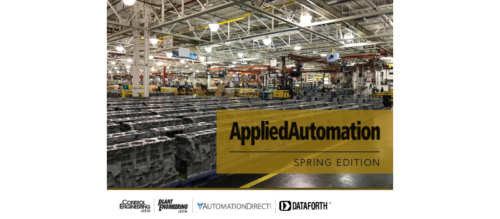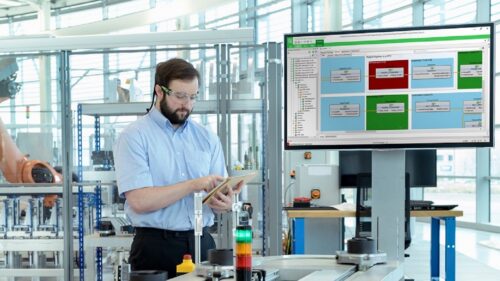Automation trends, insights from a new company president
Companies need to be open to new technologies to see fundamental paradigm shifts in productivity, beyond incremental improvements. Rapid increases in productivity, visibility, flexibility, and agility are needed.
Advantages from automation, controls, and instrumentation implementations were among topics Kevin Barker, president of Beckhoff Automation LLC, discussed with Control Engineering and CFE Media in a Feb. 26 interview at the Beckhoff U.S. headquarters, in Savage, Minn.
Automation questions, answers
Control Engineering, CFE Media: What are a few key trends driving Beckhoff product design and development that you’d like to highlight and why?
Barker: There’s been more of a focus on open technologies, programming standards, and operating environments as opposed to a particular architecture or programming language. Greater volumes of data and information are available from thousands of devices. There’s a shortage of engineering talent. All of these factors are creating a need to create better software tools that adapt to meet people where they’re at, where their skill sets are, and what comfort level they have with automation and controls technologies.
CE: What in your past has prepared you for this future?
Barker: Working for various so-called underdogs in industry, I’ve helped customers overcome the problems of existing automation choices. Incremental improvements aren’t enough; companies need to be open to new technologies to see fundamental paradigm shifts in productivity. “Good enough” just isn’t good enough anymore. For a resurgence in American manufacturing, rapid increases in productivity, visibility, flexibility, and agility are needed. We’re really well-positioned to help.
CE: What in particular can help machine builders, manufacturers and other high-tech companies succeed?
Barker: We can best help customers when they make Beckhoff Automation an extension of their engineering processes. Technology is more than a buzzword for us. Our model is different – for every salesperson, we have two engineers. This provides new ways to solve challenging problems. Engineering consulting is part of our DNA. We help build and enhance each customer’s expertise and are very application driven. With a direct-sales model, Beckhoff can reinvest a higher percentage of profits in engineering as opposed to competitors. With this consultative approach, people are amazed at the things we can solve. That’s paid for over the life of an automation project or platform. Therefore, we’re positioned to help our customers be more successful.
CE: What challenges are customers facing? Are there major differences compared to past challenges?
Barker: Manufacturers are under pressure from demographic changes due to retiring engineers coupled with too few young people going into engineering disciplines. In addition, our customers’ product proliferation has grown from dozens to thousands of options. Consumer tastes are changing. For many years, major brewers touted beer that tasted the same all the time; now consumers want unique experiences. People want a custom car, but only want to pay $40,000.
With automation and controls, engineers used to say no one would get fired for using the largest automation suppliers. Today, manufacturing leaders need to do more than not get fired. Every industry wants to deliver rich experiences with new strategies, internet, cloud, and with work instructions at the machine level to shorten the supply chain. A variety of industries, such as consumer products, automotive, advanced manufacturing, and material handling, need to advance with higher flexibility and a lot of engineering.
CE: How can some of these challenges be resolved?
Barker: Large competitors have a lot of inertia. Customers perceive a lot of risk when heading in a new direction, but they don’t have to be chained to legacy issues. We have a vision that adopts new technologies and embraces change. Rather than trying to maximize profit or growth as other technology providers do, we want to empower engineers to do incredible things. Everything we do derives from that.
CE: What isn’t being measured that should be emphasized more?
Barker: The old way often focused solely on operational equipment effectiveness (OEE) measurements. Today, we need to go above and beyond this. The first phase is to look at lifecycle costs. Then look at lost opportunity costs, the cost of not doing things because existing processes aren’t flexible enough. Are companies missing opportunities to diversify product lines? Are they meeting changing customer expectations? Are they quantifying those losses? Many industries have disrupters; we’re partnering with those who want to change.
CE: What resulting lessons learned or advice would you like to share to help customers?
Barker: In my three weeks here to date, my time has been largely internally focused, though I have been reviewing all of our customer projects. I will be spending a great deal of time in the near-term getting face to face with clients. I want to ensure that we continue to support them and reinforce how we can help with radically different, game-changing applications. Of course, there’s perceived risk in doing that, but we’re committed to their success. I want to help do what it takes to get that accomplished.
This year we’re opening many new offices: Philadelphia, Boston, Denver, Houston, and a city to be determined in Florida. I’ll help prioritize and make good investments especially in training and engineering.
CE: How is training changing?
Barker: More customers are working with technology providers to get the tools and information they need. We have opportunities to bring customers up to speed and focus around the platforms and technologies that work for them. We’re expanding our training so we can meet them where they’re at. For instance, programming is evolving to include C and other IT standards in the industrial engineering community.
CE: Are standards being used enough in operational technology implementations?
Barker: We support and encourage a big tent approach to programming and have been at the forefront of moving customers beyond non-transferable intellectual property and proprietary technology from their vendors. [Beckhoff’s TwinCAT 3 programming platform is built into Microsoft Visual Studio.]
CE: Is data transferring into intelligence as quickly as it should be?
Barker: Traditionally, we’ve had islands of automation, with platforms that don’t readily communicate. How can customers better extract, store, analyze, and make use of data, while protecting access as needed? We can help the industrial world with using MQTT and OPC UA, rather than putting 30-year-old serial technology on a faster wire.
. Platform integration of motion control, machine control, Industrial Internet of Things (IIoT), visualization, sensing technologies, and analytics is a distinct advantage.
CE: Do you have a plan and timeline to proceed?
Barker: I’ve resisted creating artificial timelines. I have an open mind and want to bring new ideas to help or add value. We are adding a dozen new employees and opening four new sales offices this quarter. We have plans to solve many of the high-level challenges discussed here, and I am preparing the organization for those.
Mark T. Hoske is content manager, Control Engineering, CFE Media, mhoske@cfemedia.com. Bailey S. Rice, CFE Media director of business and market development, helped with the questions and discussion.
KEYWORDS: Automation upgrades, IPCs
Incremental improvements aren’t enough.
Large shifts in productivity are needed.
Visibility, flexibility, and agility are needed.
CONSIDER THIS
What’s in the way of a leap to higher productivity, flexibility, visibility and agility?
ONLINE
Read more about Kevin Barker in this January news item.
Automation company selects new president
Beckhoff Automation provides more information at www.beckhoff.com.
Do you have experience and expertise with the topics mentioned in this content? You should consider contributing to our CFE Media editorial team and getting the recognition you and your company deserve. Click here to start this process.






